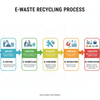How Sustainable Waste Management Strategies Protect Environment

Introduction
The world is producing more electronic waste than ever before, and this creates a major threat to the environment. Old mobiles, laptops, tablets, and chargers are thrown away every day. This type of waste is known as e-waste. Proper and sustainable waste management is important because harmful chemicals from e-waste can enter soil, water, and air. Simple actions like recycling, repairing, and reusing devices can protect the environment. This blog explains how sustainable waste strategies make a real difference and how responsible handling of e-waste helps keep the planet safe.
What Is E-Waste and Why Is It Dangerous?
E-waste includes discarded electronic products such as old mobiles, laptops, chargers, tablets, printers, and batteries. Many people throw these items into regular household bins. This is unsafe because electronic devices contain substances like lead, mercury, cadmium, and lithium. These chemicals pollute soil and water when devices break down in landfills. The burning of e-waste also releases toxic fumes into the air. Sustainable waste strategies help prevent this pollution and protect humans, animals, and plants from harmful chemicals.
Why We Need Sustainable Waste Management for Mobiles and Laptops
Mobiles and laptops are replaced frequently as new models arrive. This rapid upgrade cycle creates a huge amount of e-waste. Sustainable waste management helps reduce pollution by ensuring proper disposal and responsible recycling. It also helps recover valuable materials such as gold, copper, and rare minerals. These materials can be used again in new devices. This reduces the need to mine raw materials from the earth. Mining causes land destruction and water pollution. Sustainable waste management helps protect natural resources and lowers environmental damage.
Recycling E-Waste Reduces Pollution
Recycling is one of the best sustainable waste management methods. When mobiles and laptops are recycled properly, harmful chemicals are removed safely. Recyclers separate plastic, metal, and glass. These parts can be reused to make new products. This reduces the pollution caused by manufacturing new raw materials. Recycling also reduces the size of landfills. If people recycle e-waste regularly, there will be less toxic waste in the environment. Many countries now have special e-waste recycling centers that follow safe and eco-friendly practices.
Repairing Devices Extends Lifespan
Repairing old mobiles and laptops is another smart sustainable waste strategy. Many people buy new devices even when small repairs could keep the old one working. Simple fixes like battery replacement, screen repair, or software updates can extend the life of a device by several years. This reduces e-waste because fewer devices are thrown away. Repairing also saves money for users. When people repair instead of replace, the demand for new products decreases. This reduces manufacturing pollution and energy consumption.
Reusing Electronics Reduces the Need for New Products
Reusing old mobiles and laptops is an effective way to manage e-waste sustainably. Many devices are still in good condition and can be used by others. Donating old devices to schools, NGOs, or low-income families prevents them from becoming waste. Refurbished devices are also a growing trend. They provide affordable options for customers while helping reduce waste. Reuse reduces the pressure on natural resources because fewer raw materials are needed. It also lowers carbon emissions from manufacturing and transportation.
Safe Disposal Prevents Toxic Leaks
Some e-waste cannot be repaired or reused. These items must be disposed of safely. Safe disposal means giving the waste to certified e-waste centers. These centers have trained workers who handle toxic materials properly. They follow national and international environmental standards. Safe disposal prevents toxic leaks from old batteries, screens, and circuit boards. It keeps dangerous substances out of soil and water. A simple step like disposing of batteries in special bins protects the environment in a big way.
How Manufacturers Contribute to Sustainable Waste Management
Manufacturers play a major role in reducing e-waste. Many brands now design devices that last longer and are easier to repair. Companies are also using recycled plastic and metal in new devices. This reduces the use of raw materials and lowers pollution. Some brands have recycling kiosks where customers can drop old devices. Many companies are reducing packaging waste by using paper-based boxes instead of plastic. These steps support sustainable waste practices and reduce environmental damage.
How Users Can Reduce E-Waste in Daily Life
Users can take simple actions to support sustainable waste management:
-
Do not throw mobiles or laptops in normal dustbins.
-
Donate devices that still work.
-
Use repair services for minor issues.
-
Buy refurbished devices instead of new ones.
-
Choose brands that support recycling.
-
Store old batteries safely until you can dispose of them properly.
Simple changes like these reduce e-waste and help protect the environment.
The Role of Technology in Sustainable Waste Management
Technology is helping improve sustainable waste strategies. Modern recycling machines separate materials more safely and accurately. Artificial intelligence is used to sort e-waste faster. Many companies use apps to guide customers on how to dispose of their devices. Global organizations are also tracking e-waste to prevent illegal dumping. Better technology means safer recycling, faster processing, and less pollution. It also helps reduce the total amount of waste that enters landfills.
Economic Benefits of Sustainable E-Waste Management
Sustainable waste management creates new job opportunities in recycling, repair, and refurbishment sectors. It also recovers valuable metals from old devices. This reduces the country’s need to import raw materials. Recycled materials cost less than newly mined materials. Companies save money by using recycled parts. Users also save by buying refurbished mobiles and laptops. When e-waste is managed properly, the economy becomes stronger and more sustainable.
How Sustainable Waste Management Protects Human Health
Toxic chemicals from e-waste can cause serious health problems if they enter drinking water or farmland. These chemicals damage the nervous system, kidneys, and lungs. Children are especially at risk. Sustainable waste strategies protect human health by preventing toxic leaks and pollution. Safe recycling removes harmful substances without exposing workers or the public. Cleaner air, water, and soil help create a healthier environment for all.
Conclusion
Sustainable waste management is essential for a cleaner and safer planet. Mobiles, laptops, and other electronics contain harmful chemicals that can cause pollution if not handled properly. Simple actions like recycling, repairing, reusing, and disposing safely can reduce the impact of e-waste. Governments, manufacturers, and users must work together to build a responsible system. Every small effort matters. When we follow sustainable practices, we protect natural resources, reduce pollution, and create a better future for the next generation.
FAQs
Q.1. What is e-waste?
E-waste is old or discarded electronic items like mobiles, laptops, and chargers.
Q.2. Why is e-waste harmful?
It contains toxic chemicals that pollute soil, water, and air.
Q.3. How can I reduce e-waste at home?
Repair devices, donate working items, recycle safely, and avoid frequent upgrades.
Q.4. What is sustainable waste management?
It is the safe and eco-friendly handling of waste to protect the environment.
Q.5. Can old mobiles and laptops be recycled?
Yes, almost all electronics can be recycled at certified centers.





